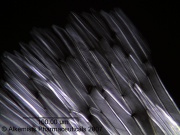Chamaemelum nobile (flower)
| Line 11: | Line 11: | ||
=Macroscopic Entries= | =Macroscopic Entries= | ||
=Microscopic Entries= | =Microscopic Entries= | ||
| − | + | {{Microscopy | source=Elan M. Sudberg, Alkemist Laboratories-British Pharmacopoeia, 2003 | |
| − | {{ | + | | companyimage= AP-LOGO-Laboratories Crop - Copy.jpg |
| + | | companyURL=http://www.Alkemist.com | ||
| + | | mainimage=Roman_chamomile.jpg | ||
| + | | caption1=Thin walled cells of paleae seen in polarized light observed at 400x with Acidified Chloral Hydrate Glycerol Solution. | ||
| description=Roman Chamomile (flowers) (''Anthemis nobilis'') | | description=Roman Chamomile (flowers) (''Anthemis nobilis'') | ||
| − | + | | image2=Roman_chamomile-1.jpg | |
| − | + | | caption2=Long covering trichome with 4 short basal cells observed at 400x with Acidified Chloral Hydrate Glycerol Solution. | |
| + | | characteristics=cellular structures identified in this botanical specimen are the thin walled cells of paleae seen in polarized light and the long covering trichome with 4 short basal cells when observed at 400x with Acidified Chloral Hydrate Glycerol Solution. | ||
| + | | }} | ||
=HPTLC Entries= | =HPTLC Entries= | ||
=Other Points of Interest= | =Other Points of Interest= | ||
Revision as of 01:03, 25 September 2012
Contents |
Introduction
Introduction from Wikipedia, the free encyclopedia (http://en.wikipedia.org/wiki/Anthemis_nobilis, retrieved 02/20/2012).
Anthemis nobilis [synonym: chamaemelum nobile], commonly known as Roman camomile, chamomile, garden camomile, ground apple, low chamomile, English chamomile, or whig plant, is a low perennial plant found in dry fields and around gardens and cultivated grounds. It has daisy-like white flowers that are found in Europe, North America, and Argentina. The stem is procumbent, the leaves alternate, bipinnate, finely dissected, and downy to glabrous. The solitary, terminal flowerheads, rising 8 to twelve inches above the ground, consist of prominent yellow disk flowers and silver-white ray flowers. The flowering time is June and July, and its fragrance is sweet, crisp, fruity and herbaceous.
The plant is used to flavor foods, in tisanes, perfumes, and cosmetics. It is used to make a rinse for blonde hair, and is popular in aromatherapy, whose practitioners believe it to be a calming agent to end stress and aid in sleep.
The word chamomile comes from Greek χαμαίμηλον (chamaimēlon), "earth-apple", from χαμαί (chamai), "on the ground" + μήλον (mēlon), "apple", so called because of the applelike scent of the plant. (Note: The "ch-" spelling is used especially in science and pharmacology.)
The quoted text in this section was licensed for use under the Creative Commons ShareAlike License, version 3.0: http://creativecommons.org/licenses/by-sa/3.0/
Macroscopic Entries
Microscopic Entries
|
HPTLC Entries
Other Points of Interest
Cite error: <ref> tags exist, but no <references/> tag was found

